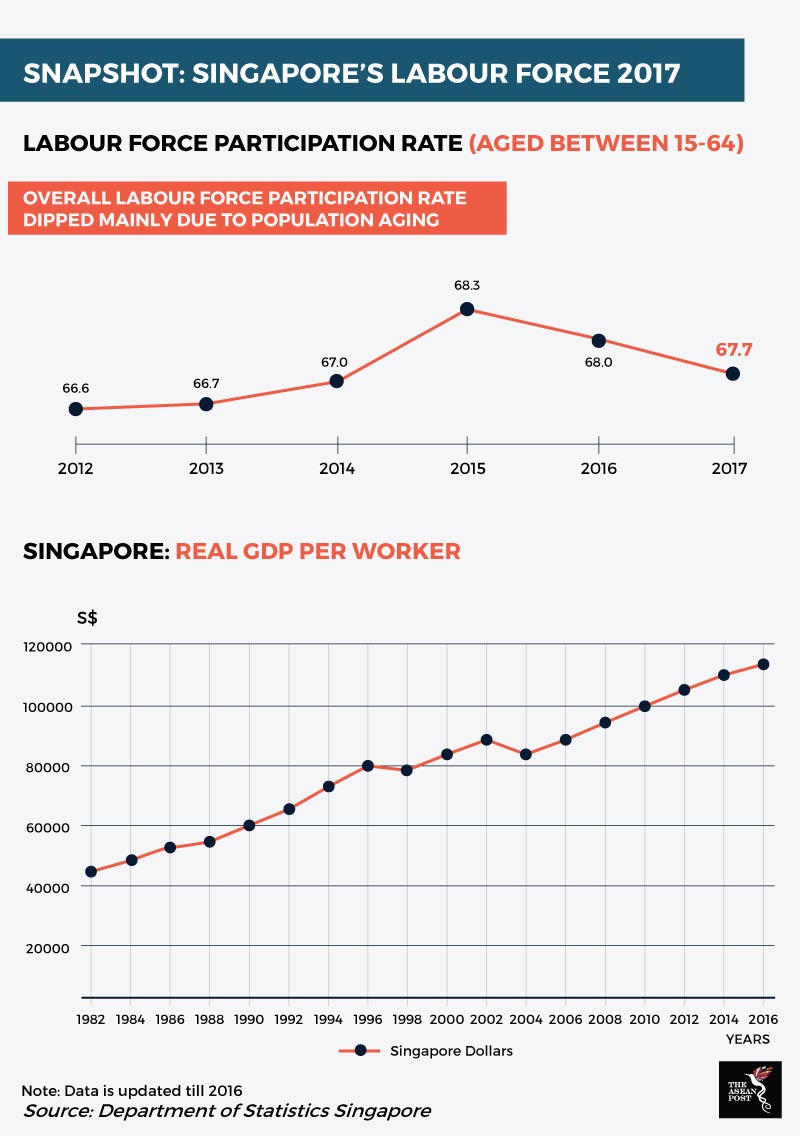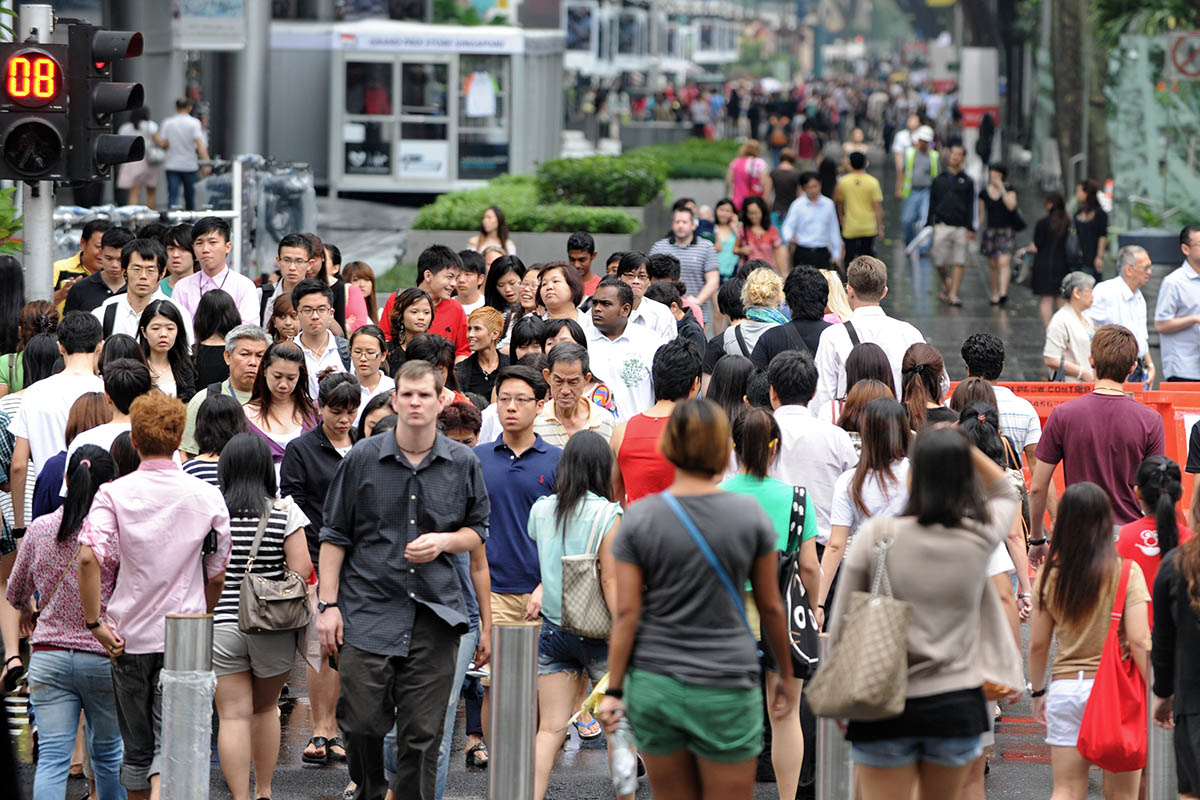Singapore’s economy expanded by 3.5% in 2017, according to estimates released by the Ministry of Trade and Industry earlier this month. Yet the percentage of its labour force aged over 60 years also rose from 6.1% in 2007 to 14.1% in 2017, according to a recent report by the Ministry of Manpower (MOM).
The labour force participation rate (LFPR) in 2017 meanwhile dropped to 67.7% from 68% in 2016 according to MOM data. The LFPR is the percentage of the labour force aged between 15-64 that is either engaged in employment or actively seeking for it.
Meanwhile, Singapore’s total fertility rate has averaged between 1.15-1.20 (against the global average of 2.10) between 2010 and 2016, according to the Department of Statistics of Singapore.
Lower fertility rates and an aging population will potentially shrink Singapore’s labour force.
The shrinking labour force is expected t have a negative impact on Singapore’s GDP per capita. According to a study by the Institute of Policy Studies it is expected to shrink by 1.5 percentage points yearly between now and 2060.
Speaking at the Singapore Perspectives 2018 conference recently, Ravi Menon, managing director of the Monetary Authority of Singapore (MAS) outlined how Singapore’s GDP growth essentially amounted to the sum total of productivity growth and labour force growth.
In other words, tackling Singapore’s labour shortage problems could be done either by expanding the labour force or increasing its productivity growth.
This translates to the need for higher labour productivity overall.
According to Singapore’s Ministry of Manpower (MOM), labour productivity is measured by calculating the contribution of labour against other factors like capital investment, new technology, the health and skills of workers and the use of more efficient management and production practices.

Enhancing the quality of foreign labour
To increase labour productivity, Singapore has to re-evaluate the existing resources of resident and foreign labour at its disposal.
Singapore could increase its foreign labour productivity by focusing on quality rather than quantity, Menon said.
Singapore has 1,374,000 foreign workers as of June 2017, according to MOM data. This constitutes about 36% of its labour force, a drop from the 1,393,000 foreign workers it had in 2016.
Menon also noted that the number of work permit holders had fallen by 10 percentage points over the last 10 years, while the number of S Pass (for mid-level skilled staff) and employment pass holders (for foreign professionals, managers and executives) had increased by 10 percentage points. He said this trend needed to continue as the economy underwent further restructuring towards digitalisation.
Devadas Krishnadas, chief executive of Future-Moves group, however, noted the distinction between skilled and unskilled foreign labour. While the former are productivity enablers, the latter’s higher availability tends to discourage companies from pursuing capital-intensive productivity measures.
In his opinion piece, he also suggested the introduction of new visa categories for foreign workers in Singapore. These, he suggested, could be limited to terms of up to three-to-five years. To ensure productivity was kept up, renewing these visas could be made conditional upon proven work performance.
Improving the jobs-skills match for resident labour
Singapore also needs to correctly position its resident labour force within the changing economic landscape.
With the transformation of industries, new job scopes requiring new skills would also become available, and resident labour would only be able to harness these opportunities if they receive the right training. This is because a jobs-skills mismatch has been identified by the MOM as a continuing structural challenge in face of the economic restructuring.
The Singapore government, under its Professional Services Industry Transformation Roadmap, launched the Professional Conversion Programs in 2016 to develop specialised skillsets needed in 23 fields. This year, new programs will be launched in the areas of internet audit and building information modelling, among other knowledge fields.
JobTech Pte Ltd in its 2018 Job Markets Census recommends employees to train in the areas of science and technology to increase their employability. This recommendation was based on 2017 data that demand for online jobs had increased by 9.6% across sectors in the fourth quarter of 2017 alone.
Meanwhile, it is also crucial to ensure that there are mechanisms in place for older Singaporeans to be retrained in new skills.
“Middle-aged professionals, managers, executives and technicians (PMETs) who are midway through their careers are particularly vulnerable,” said David Ang, corporate services director at Human Capital Singapore. He was commenting on the recent labour market report released by the Ministry of Manpower (MOM).
Government initiatives like WorkPro’s Job Redesign Grants have so far benefited more than 200 companies, according to the MOM. Companies are free to apply for grants of up to S$300,000 per company to accommodate workers aged above 50 into their workflows. The grants were launched in 2016 with the aim of developing age-friendly work environments which would allow older employees to continue serving the workforce.
“Ultimately, I think it is important for our employers and also the older workers to recognise one thing. That in this day and age of rapid development globally, I think companies and workers will have to rejuvenate themselves; reinvent themselves, to be able to compete effectively, globally,” said Sam Tan, Minister of the State for Manpower during an interview in July 2017.
With lower fertility rates, effective management of its labour will present a challenge to Singapore for years to come. Despite the setbacks, Singapore has already shown that it is capable of making decisions that can benefit its population and economy in the long run.
Recommended stories:
